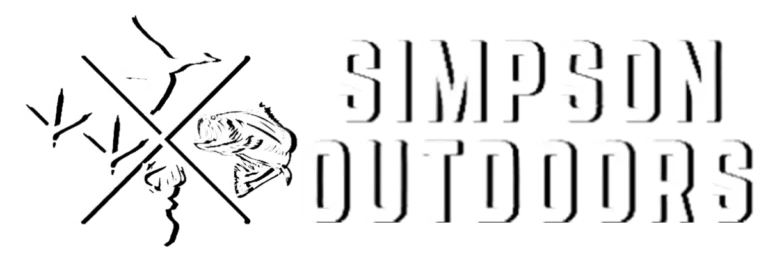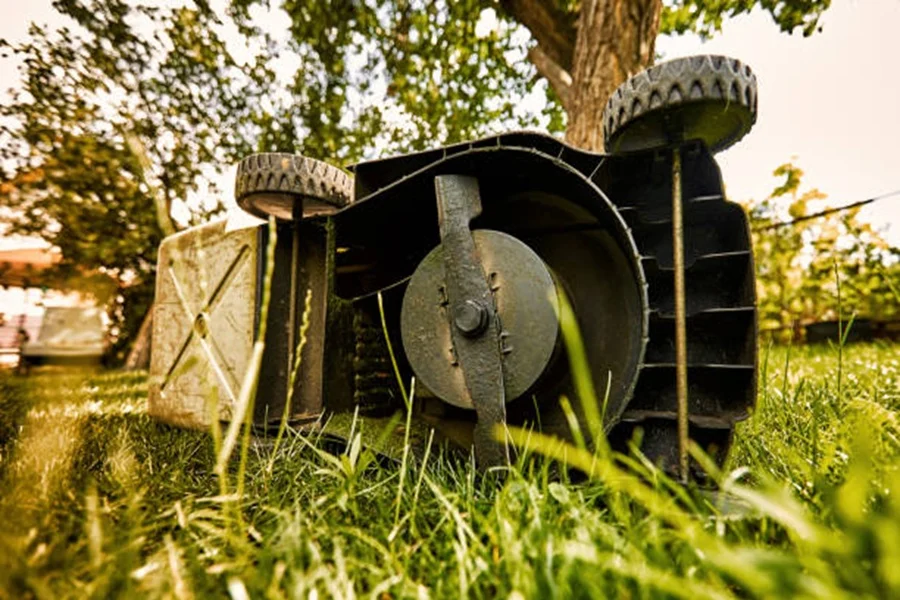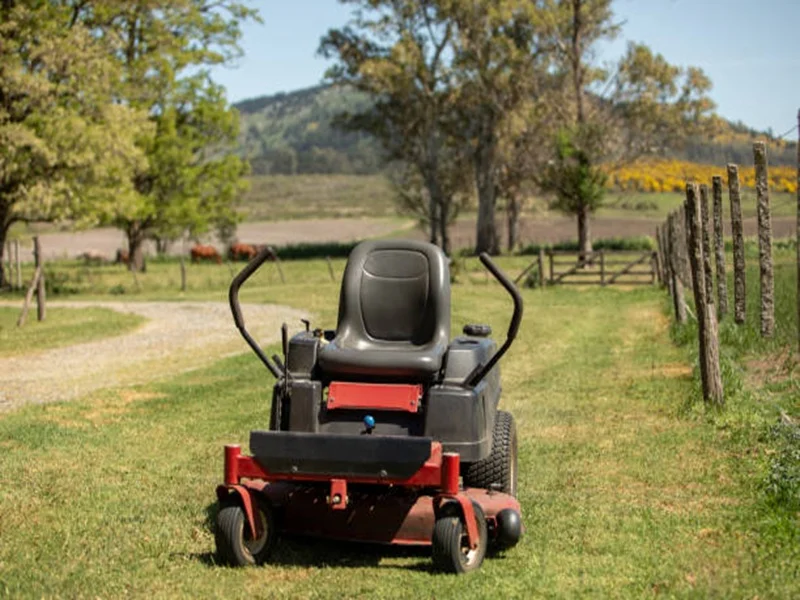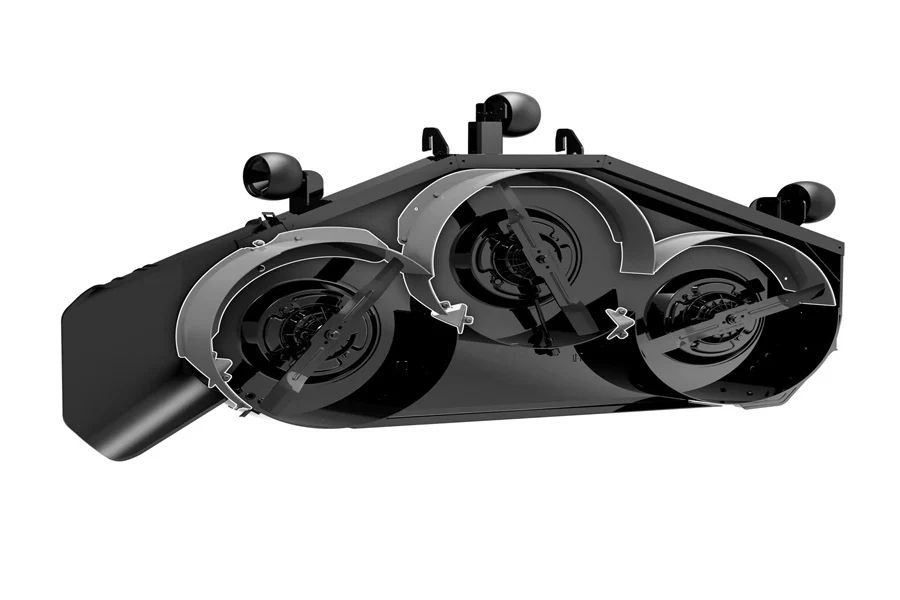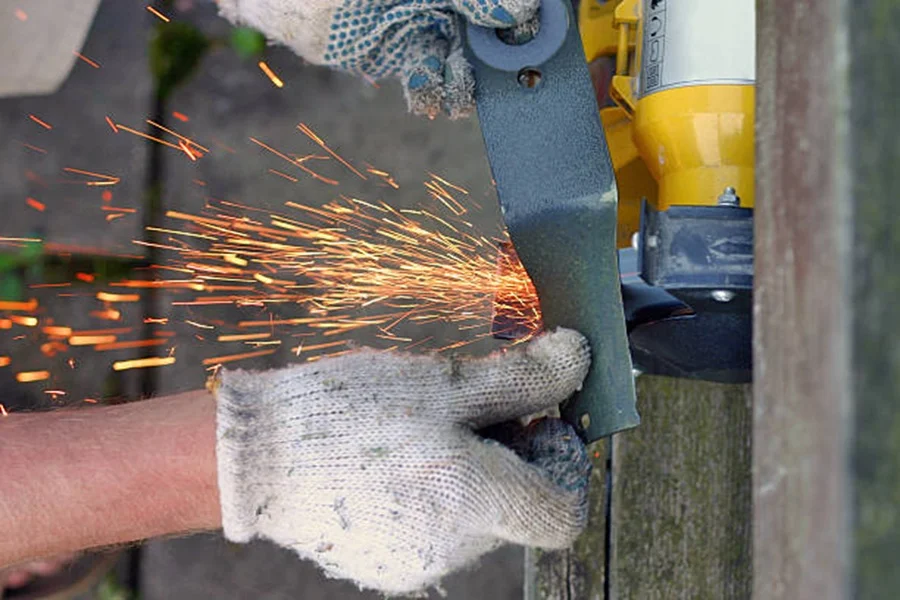Mowing with Dull Blades
A well-maintained lawn mower blade is one of the most critical components for achieving a healthy, vibrant lawn. Mowing with dull blades can lead to a host of problems that not only affect the look of your turf but also its overall health.
Why Dull Blades Are a Problem
- Frayed Grass Tips: Grass ends appear brown and ragged, reducing the visual appeal of your lawn.
- Increased Stress on Grass: Damaged grass spends more energy repairing itself, leaving it vulnerable to diseases and pests.
- Uneven Cuts: Dull blades can result in an inconsistent cut, leading to patches and uneven growth patterns across your yard.
Signs Your Blade Needs Sharpening
- Grass tips turning brown shortly after mowing.
- Visible tearing or shredding on grass blades upon closer inspection.
- The mower requiring extra effort or multiple passes to achieve a cut.
How Often Should You Sharpen Lawn Mower Blades?
Experts recommend sharpening your mower blades at least twice during the mowing season or every 20-25 hours of use, whichever comes first. However, if you mow over thick debris, rocks, or sticks frequently, you may need to sharpen them more often.
| Sharpening Frequency Guide | Frequency |
| Regular Mowing (No Debris) | Twice per mowing season |
| Heavy Use or Debris-Prone Areas | Every 10 hours of use |
Tips for Proper Blade Maintenance
- Inspect Before Each Use: Check for nicks, bends, or dull edges before starting the mower.
- Sharpen Blades Safely: Use a dedicated blade sharpener or take them to a professional sharpening service if you’re unsure how to do it yourself.
- Balance Matters: After sharpening, make sure the blade is balanced properly; unbalanced blades can strain the engine and result in uneven cuts.
- Avoid Rocks and Debris: Clear your lawn of any clutter like rocks, branches, and toys before mowing as these can damage the blade edge quickly.
By maintaining sharp mower blades throughout the mowing season, you ensure that each cut promotes healthy growth rather than causing unnecessary harm to your turfgrass. This simple yet effective step will help you achieve not only an attractive lawn but one that is resilient against environmental stresses such as droughts and diseases without compromising efficiency during maintenance tasks.
MOWING WITH DULL BLADES
Mowing your lawn with dull blades is a common mistake that can have long-term consequences for the health and appearance of your grass. Sharp mower blades are essential for maintaining a clean cut, reducing stress on your lawn, and preventing potential problems such as disease and discoloration. Here’s why dull blades are an issue, how to identify the problem, and steps you can take to ensure your mower is always ready for action.
Why Dull Blades Are Harmful
- Frayed Grass Tips: Torn grass tips often turn brown and give the lawn an unhealthy, scorched look.
- Increased Disease Risk: Damaged grass is more susceptible to fungal infections due to open wounds at the cut site.
- Weakened Lawn Growth: Grass struggles to recover from rough cuts, leading to slower growth and reduced resilience.
- Higher Fuel or Energy Consumption: Dull blades force the mower’s engine (gas or electric) to work harder, making it less efficient over time.
Signs That Your Blades Might Be Dull
- The grass tips look shredded or brown after mowing.
- Mowing takes longer than usual because the machine struggles through the grass.
- You notice uneven patches where some areas aren’t being cut properly.
- The overall look of the lawn becomes less polished and healthy over time.
How Often Should You Sharpen Your Blades?
| Frequency of Use | Recommended Sharpening Interval |
| Once a week (standard) | Every 2 months |
| Twice a week | Monthly |
| Heavy-duty use | Every 20 hours of mowing |
How To Sharpen Your Blades
- Disconnect the Power Source: Whether it’s gas or electric, ensure safety by disconnecting spark plugs or batteries.
- Remove Blade Carefully: Use gloves and proper tools to remove the blade from underneath the mower.
- Clean Off Residue: Before sharpening, wipe off dirt or debris using water and a wire brush.
- Sharpen Using Proper Tools: A metal file or bench grinder works well—sharpen at an angle consistent with its original edge.
- Balance Is Key: After sharpening, check balance by placing it on a balancing tool or nail; an out-of-balance blade can cause vibration when mowing.
- Reinstall Securely: Ensure bolts are fastened tightly before reattaching power sources.
If you’re unsure about sharpening yourself, many lawn care centers offer professional services at affordable rates.
Preventative Measures
To extend blade life and reduce wear-and-tear: – Always clear your yard of rocks, toys, sticks, and other debris before mowing. – Avoid using your lawnmower on overly tall grass—cut in stages if necessary. – Check blade condition regularly as part of routine maintenance.
Properly maintained mower blades make all the difference when it comes to achieving an even cut while promoting healthier growth overall—ensuring your lawn looks its best throughout every season!
MOWING THE SAME DIRECTION EVERY TIME
Mowing the lawn in the same direction each time may seem like a harmless habit, but it can lead to a variety of issues that affect the appearance, health, and longevity of your grass. This section will explain why varying your mowing pattern is essential and provide practical tips to implement this strategy effectively.
Why It’s Problematic
- Soil Compaction: The tires or wheels of your mower can compact the soil over time when they follow identical paths. Compacted soil makes it harder for grass roots to grow deep and access water and nutrients.
- Uneven Cut: Grass can start leaning in one direction due to repetitive mowing patterns, resulting in an uneven appearance.
- Weakened Grass Blades: Constant pressure on grass blades in a singular direction can weaken them, making them more prone to damage from pests or diseases.
- Striping Limitations: If you aim for visually pleasing mowing stripes on your lawn but always mow the same way, the effect becomes less noticeable and lacks variation over time.
Benefits of Changing Directions
- Promotes upright growth by preventing grass from leaning permanently in one direction.
- Helps distribute wear evenly across the lawn surface, avoiding visible ruts or tracks.
- Reduces soil compaction by spreading out foot traffic or mower wheel weight.
- Creates more dynamic, professional-looking patterns or stripes across your yard.
Best Practices for Alternating Mowing Patterns
- Change Directions Each Week: Rotate between horizontal (east-west) and vertical (north-south) patterns weekly during mowing season for an evenly groomed surface.
- Diagonal Cuts: Every third or fourth mow, try cutting diagonally across your yard (e.g., northeast-southwest) to further diversify patterns.
- Overlap Edges Properly: Ensure slight overlaps on passes regardless of direction change to avoid leaving strips of uncut grass.
- If specific areas of your yard show signs of wear or compaction, adjust wheel paths accordingly to give those sections recovery time.
- Consider aerating heavily compacted spots annually.
| Direction Change Frequency | Pattern Example | Benefits |
| Weekly | North-South/East-West | Encourages upright blade growth |
| Biweekly | Add diagonal cuts | Enhances aesthetic appeal |
Tools That Help With Direction Changes
- Self-propelled mowers make turning easier on hilly lawns by reducing physical effort.
- A mower with adjustable cutting heights ensures a clean cut regardless of pattern changes.
- Sharpened blades are critical for uniform cutting; dull blades exacerbate unevenness when switching directions.
Implementing these strategies fosters a healthier lawn that stands up better to environmental stresses while also enhancing curb appeal through varied striping techniques—making small adjustments highly worthwhile for any homeowner aiming for long-term results.
MOWING THE SAME DIRECTION EVERY TIME
Mowing in the same direction every time may feel like an efficient routine, but it can have a surprisingly negative impact on your lawn’s health and appearance. Over time, this habit can create uneven growth patterns, soil compaction, and even weaken the grass. To maintain a lush and healthy lawn, it’s essential to introduce variety into your mowing technique.
Why Avoid Mowing in the Same Direction?
- Repeatedly moving in the same path causes the wheels of your mower to press into the soil. Over time, this compacts the ground beneath those tracks, restricting airflow and water absorption. Grass roots struggle to grow in compacted soil.
- Grass tends to lean or grow in the direction it’s mowed. By consistently mowing in a single direction, you’ll encourage uneven growth patterns that can make your lawn look patchy or unkempt.
- Consistently cutting grass from one angle may cause stress on certain areas of your lawn as some blades of grass are repeatedly bent or torn rather than cut cleanly.
- Mowing from different angles allows you to catch grass blades that might have been missed during previous passes due to their natural lean or overlap with other blades.
Best Practices for Alternating Your Mowing Pattern
- Rotate Directions Regularly: Change your mowing pattern each session—this could mean alternating between vertical, horizontal, diagonal, or circular paths.
- Use a Simple Rotation Schedule: For example:
| Week | Pattern | |——|———| | 1 | North-South (vertical) | | 2 | East-West (horizontal) | | 3 | Diagonal (45° angle) | | 4 | Opposite diagonal | - Overlap Slightly: No matter what direction you choose for that session, make sure each pass overlaps slightly with the previous one to ensure an even cut.
- Watch for Lawn Stress: Pay attention to areas where grass might start looking flattened or discolored—this can indicate over-compaction from repetitive patterns.
Benefits of Changing Directions
- Promotes uniform growth across all areas of your lawn.
- Prevents tire track marks that flatten patches of grass.
- Enhances airflow and loosens compacted soil over time.
- Encourages stronger root systems by reducing stress on specific areas.
Additionally, changing directions can turn mowing into a more enjoyable experience—it feels less monotonous when you’re not following the same path every week!
By intentionally varying your mowing routine, you not only enhance your lawn’s aesthetics but also contribute positively to its long-term health. This small adjustment can make a noticeable difference over time while saving you from potential issues caused by repetitive habits.
BAGGING YOUR GRASS
When it comes to maintaining a healthy lawn, one of the most debated practices is whether or not to bag grass clippings after mowing. While bagging may seem like the cleanest approach, it isn’t always the best choice for your lawn’s health or the environment. Understanding when and why to bag—or leave clippings on the lawn—can make a significant difference in the long-term appearance and vitality of your turf. Below, we’ll break down the pros and cons of bagging grass, along with practical tips to help you decide what’s best for your yard.
The Pros of Bagging Grass Clippings
- Dealing with Disease: If your grass shows signs of fungal infections or diseases such as brown patch or rust, removing clippings can prevent further spread.
- Excessive Thatch Build-Up: In cases where there’s already a thick thatch layer (a dense mat of organic matter), adding more clippings can exacerbate problems by slowing water and nutrient penetration.
- Post-Weeding Lawn Maintenance: If you’ve recently treated your yard with herbicides or removed weeds manually, bagging ensures no seeds will redistribute across your lawn.
Reasons Not to Bag Grass Clippings
- Nutrient Recycling: Grass clippings decompose quickly and return valuable nutrients like nitrogen, phosphorus, and potassium to the soil. This natural fertilization process can reduce your reliance on synthetic fertilizers.
- Improved Soil Health: Over time, decomposing clippings improve soil structure by increasing organic matter content.
- Environmental Benefits: By avoiding bagging, you reduce yard waste sent to landfills. According to environmental organizations, yard waste makes up a significant portion of landfill material.
| Practice | Pros | Cons |
| Bagging Grass | Reduces disease spread; keeps lawns tidy | Removes natural nutrients; creates unnecessary waste |
| Grasscycling | Nourishes soil; eco-friendly; saves time | May require more frequent mowing if growth is rapid |
Tips for Managing Grass Clippings
- Mow Regularly: Avoid cutting more than one-third of the blade height at a time. Longer clippings are harder to decompose if left behind.
- Use Mulching Blades: These specialized blades finely chop grass into smaller pieces that break down quicker when left on the ground.
- Mow When Dry: Wet clippings tend to stick together, making them more likely to smother underlying grass whether they’re left behind or collected in bags.
When Bagging Makes Sense
- During fall cleanup, collecting leaves along with grass clippings can prevent debris from suffocating turf through winter months.
- After prolonged periods without mowing (e.g., vacations), collecting abnormally long cuttings ensures they don’t form thick mats that block sunlight.
Bagging doesn’t need to be an all-or-nothing decision; consider alternating between both methods depending on conditions in your yard.
By balancing these practices thoughtfully and observing how they affect your lawn over time, you’ll be able to develop a routine tailored specifically for its health and appearance while minimizing waste generation in an eco-conscious way.
BAGGING YOUR GRASS
Bagging grass clippings after mowing is a practice many homeowners follow, believing it keeps their lawn cleaner and healthier. While there are situations where bagging is useful, this approach may not always be the best choice for your lawn’s health. Let’s examine the implications of this habit and explore when and why you might reconsider it.
Downsides of Bagging Grass Clippings
- Loss of Natural Nutrients: Grass clippings contain essential nutrients like nitrogen, phosphorus, and potassium that naturally decompose and feed the soil. Removing them deprives your lawn of this free source of sustenance.
- Increased Waste: Bagging grass contributes to landfill waste. In landfills, green waste often decomposes without enough oxygen, producing methane—a potent greenhouse gas.
- Time and Effort: Handling clippings adds extra time to your mowing routine. From emptying bags to disposal logistics, this step can become needlessly tedious.
Benefits of Leaving Clippings on Your Lawn
- Natural Fertilization: Clippings break down quickly, enriching the soil with organic matter and nutrients.
- Improved Soil Health: Organic material from decomposed clippings fosters beneficial microbial activity in the soil.
- Moisture Retention: A thin layer of clippings helps maintain soil moisture by reducing evaporation rates during hot weather.
- Cost Savings: By utilizing natural fertilization from clippings, you may reduce or eliminate the need for store-bought fertilizers.
When Should You Bag Grass?
| Scenario | Why Bagging Is Recommended |
| Lawn Has Weeds | Prevents spreading weed seeds through clippings |
| Post-Disease Treatment | Reduces risk of reinfecting healthy growth |
| Overgrown or Thick Grass | Dense clumps may smother existing turf |
| Preparing for Composting | Clippings can contribute to a balanced compost pile |
Practical Tips for Effective Grasscycling
- Mow Frequently: Avoid cutting more than one-third of the blade height at a time; shorter pieces decompose more efficiently.
- Use a Mulching Mower Blade: These specially designed blades chop clippings into smaller particles that break down faster.
- Avoid Wet Conditions: Wet grass can create thick patches that block sunlight or trap excess moisture, potentially damaging turf.
- Check Lawn Health Regularly: Watch for signs of fungal growth or over-compaction if you’re consistently leaving clippings on the ground.
By understanding both the pros and cons of bagging your grass, you’ll be better equipped to tailor lawn care practices that promote long-term health while saving time and reducing environmental impact.
BAGGING YOUR GRASS
When mowing your lawn, deciding what to do with the grass clippings is an often-overlooked yet impactful consideration. Many homeowners automatically reach for their grass catcher or bag attachment, assuming that bagging clippings is the best option for a neat and tidy yard. However, while there are some instances where bagging grass may be appropriate, doing it habitually can inadvertently deprive your lawn of essential nutrients and create unnecessary waste. Let’s explore this topic in depth.
Downsides of Bagging Grass Clippings
- Nutrient Loss: Grass clippings are a natural fertilizer. When left on the lawn after mowing, they decompose and return valuable nutrients like nitrogen, phosphorus, and potassium to the soil. Removing them denies your lawn these natural benefits.
- Increased Waste: Bagged grass typically ends up in landfills unless specifically composted. This contributes to unnecessary organic waste that could otherwise be reused beneficially.
- Added Effort: Bagging creates more work for you during and after mowing because you’ll need to empty the catcher frequently and dispose of the clippings properly.
When Should You Bag Grass?
- Dealing with Weeds or Disease: If your lawn has invasive weeds or fungal issues, bagging can help prevent spreading seeds or pathogens throughout your yard.
- Overgrown Lawns: If you’ve allowed your grass to grow too tall before mowing, long clippings may create unsightly clumps when left behind. In such cases, bagging ensures a cleaner finish.
- Aesthetic Preferences: For those who prioritize a highly manicured appearance without any visible debris, bagging might align better with their vision.
Best Alternatives to Bagging
- Use a mulching mower designed to finely chop clippings so they break down quickly into the soil.
- Mow frequently enough that no more than one-third of the blade height is removed at once; smaller cuttings decompose faster.
- Collect clippings as part of a composting system if you want to use them later as organic material for garden beds or other landscaping projects.
- Combine green materials like grass with brown materials (e.g., dried leaves) for balanced decomposition.
| Scenario | Recommended Action | Why? |
| Healthy Lawn | Grasscycling | Returns nutrients; improves soil health |
| Overgrown Lawn | Bagging | Prevents thick layers of cuttings from smothering growth |
| Weed Infestation | Bagging | Reduces spread of seeds |
| Fungal Diseases | Bagging | Minimizes contamination across other parts of the lawn |
Practical Tips for Managing Grass Clippings
- Keep mower blades sharp to ensure clean cuts; this reduces stress on both grass blades and decomposition time for any leftover clippings.
- Adjust mower height appropriately—cutting too short (scalping) stresses turfgrass and creates excessive debris that’s harder for soil microbes to process.
- Monitor weather conditions before mowing; avoid cutting wet grass since it causes uneven distribution of clumps whether you’re mulching or bagging.
By thoughtfully considering how you manage your grass clippings during regular mowing sessions, you can maintain a healthier lawn while reducing labor demands and environmental impact over time.
